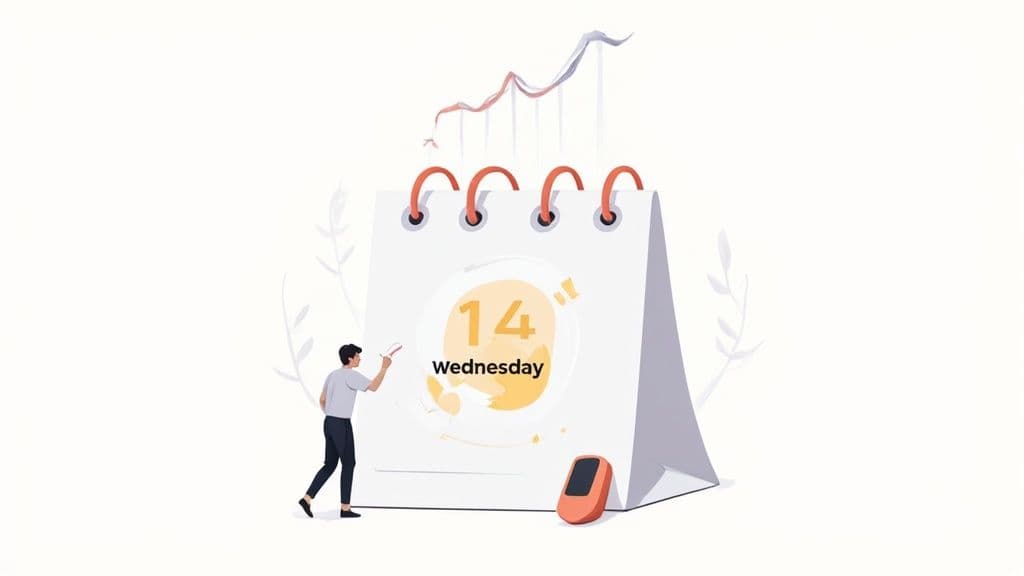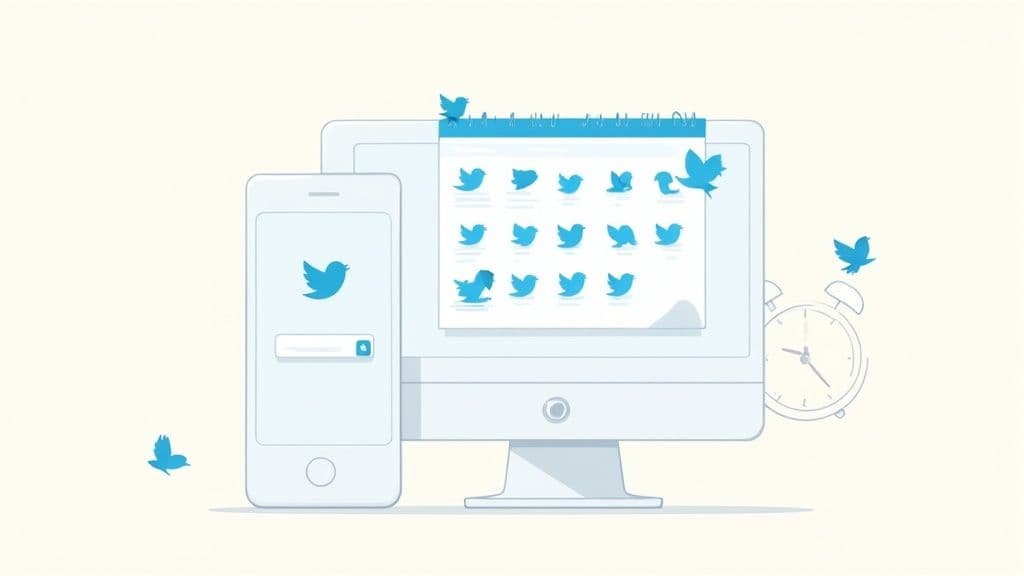Ever wondered why some social media posts take off while others barely make a ripple? The secret often lies not just in what you post, but when you post it. Timing is a critical, yet often overlooked, component of a successful social media strategy.
Posting when your audience is most active dramatically increases visibility, boosts engagement rates, and ensures your message lands with maximum impact. This guide cuts through the noise of generic advice. We will explore the data-backed best day for social media posts across different platforms, industries, and strategic goals. Identifying these peak times is fundamental to building a high-performing content plan.
Whether you're a B2B marketer, a lifestyle brand, or growing a personal account, understanding these temporal sweet spots is your first step toward transforming your social media performance. To truly master timing and capitalize on trending moments throughout the year, you might want to consider leverage a social media holiday calendar.
This comprehensive roundup provides actionable insights into the days that deliver the highest engagement. We will cover:
- The peak engagement windows during the workweek.
- How to adjust your strategy for B2C versus B2B audiences.
- Platform-specific timing for maximum reach.
- The importance of testing and adapting to your unique followers.
We'll also show you how to leverage a tool like Postiz to turn this knowledge into a powerful, automated content machine. Let's move beyond guesswork and start scheduling for success.
1. Wednesday: The Peak Engagement Sweet Spot
If you could only choose one day to post your most important content, Wednesday would be it. Across numerous studies and platforms, Wednesday consistently stands out as the best day for social media posts, hitting a unique "sweet spot" in the weekly cycle. By midweek, the initial rush of Monday and Tuesday has subsided, and your audience has settled into their routine. They are more likely to take mental breaks, scroll through their feeds, and actively engage with content that catches their eye.
This isn't just a hunch; the data backs it up. Research indicates that Wednesday posts can receive significantly higher engagement compared to the start or end of the workweek. Users are neither buried under an avalanche of "welcome to the week" tasks nor have they mentally checked out for the upcoming weekend. This creates a perfect window where they are receptive, attentive, and ready to interact.
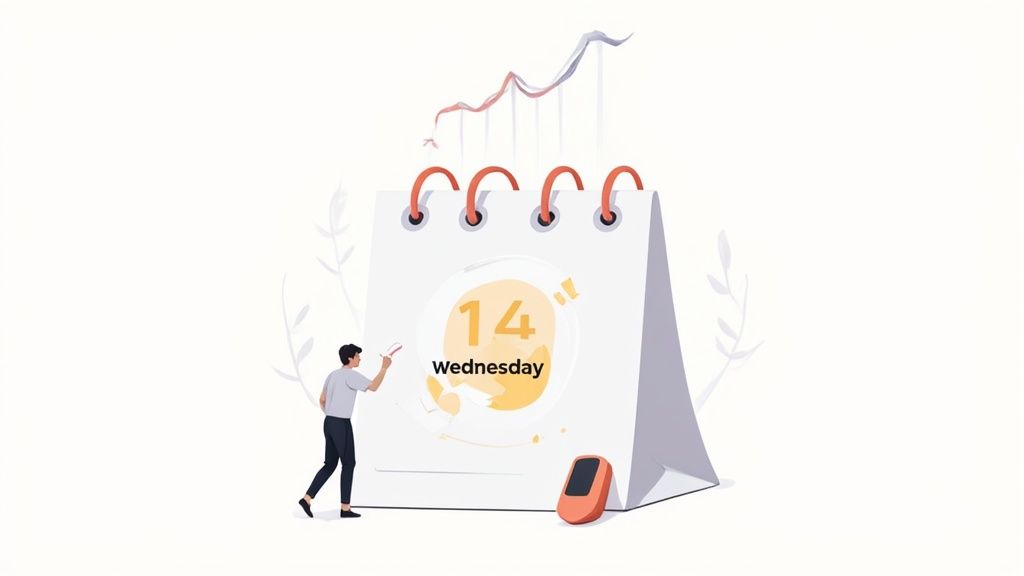
Why Wednesday Works So Well
The logic behind Wednesday's success is rooted in user behavior. People have conquered the first part of the week and are looking for a bit of a lift to get them over the "hump." This often translates to more time spent on social media during breaks, especially around lunchtime.
- HubSpot's data revealed their Wednesday posts generated an impressive 35% more shares than content posted on other weekdays.
- Hootsuite's research points to Wednesday at 11 AM as the prime time for B2B content, capturing professionals just before their lunch break.
- Buffer's analysis showed that posts published on Wednesday afternoons achieved the highest rates for both saves and shares, indicating deeper user interest.
How to Make Wednesday Work for You
Capitalizing on this peak engagement day requires a strategic approach. It's not just about posting; it's about posting the right content at the right time.
- Time Your Posts: Aim to publish between 11 AM and 1 PM. This window aligns perfectly with the common lunch break, a period when many users actively scroll their social feeds.
- Schedule Your Best Content: Save your most valuable, engaging, or important announcements for Wednesday. Use a tool like Postiz to schedule these posts in advance, ensuring you never miss this crucial window.
- Establish a Baseline: Test your Wednesday posting strategy consistently for 4-6 weeks. This will help you gather enough data to understand what resonates with your specific audience and establish a performance baseline to measure against. By tracking these metrics, you can learn more about how to boost your social media engagement and refine your overall strategy.
2. Thursday and Friday: Pre-Weekend Engagement Surge
As the workweek winds down, user behavior on social media begins to shift, making Thursday and Friday strategic days for posting. This pre-weekend period captures an audience that is transitioning from a professional mindset to a more relaxed, personal one. Thursday often maintains the strong engagement levels of midweek, while Friday taps into the anticipation and planning for the days off, creating unique opportunities for different types of content.
This two-day window allows brands to connect with users in distinct ways. On Thursday, audiences are still focused and receptive to valuable information, but by Friday, their attention turns towards entertainment, lifestyle, and weekend activities. Understanding this shift is key to determining the best day for social media posts that align with your brand's goals and your audience's mood.
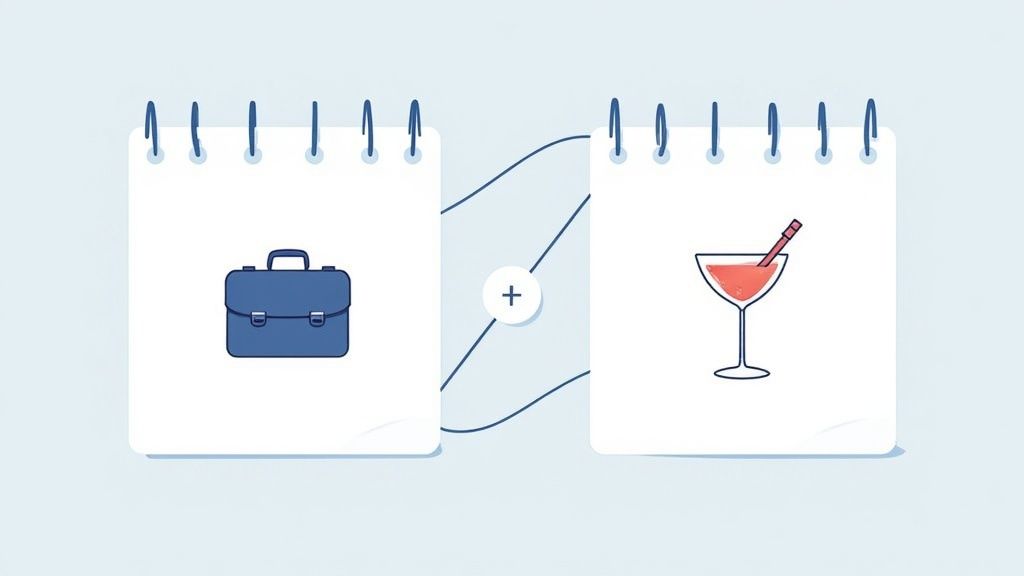
Why Thursday and Friday Work So Well
The effectiveness of this end-of-week period is rooted in psychological shifts. People are looking forward to the weekend, making them more receptive to content that is either conclusive (wrapping up work themes) or aspirational (planning for leisure). This creates a powerful surge in engagement for brands that time their content correctly.
- Sprout Social data shows that Instagram Stories posted on Friday afternoons can achieve 25% higher completion rates, as users are more inclined to consume casual, bite-sized content.
- Travel brands like Airbnb often see a significant engagement lift on Fridays. Some reports indicate up to 40% higher engagement on posts featuring vacation content as users plan their getaways.
- Entertainment giants like Netflix frequently release promotional content and trailers on Thursdays and Fridays to build hype and capitalize on weekend viewing habits.
How to Make Thursday and Friday Work for You
To leverage the pre-weekend surge, you need to tailor your content to the specific day and the corresponding user mindset. It’s a tale of two very different, yet equally valuable, days.
- Differentiate Your Days: Use Thursday for more professional content, thought leadership, or product launches. Reserve Friday for lighter, more engaging content like entertainment, inspirational stories, or posts themed around weekend plans.
- Post Earlier on Friday: To catch users before they mentally (or physically) check out for the weekend, schedule your Friday posts between 9 AM and 11 AM. This timing maximizes visibility before the weekend disconnect begins.
- Build Weekend Anticipation: Create content that resonates with the "Friday feeling." Ask questions about weekend plans, share user-generated content related to leisure, or offer special weekend promotions. Use a tool like Postiz to schedule these timely posts and ensure you connect with your audience when they're most receptive.
3. Avoid Sundays for Professional Content
While identifying the best day for social media posts is crucial, understanding the worst day is just as important for a well-rounded strategy. For most professional and business-focused content, Sunday consistently ranks as the lowest-performing day. Users are typically in "weekend mode," disconnecting from work and focusing on personal activities, family, and relaxation.
This shift in mindset leads to a significant drop in engagement for brand-centric or industry-related posts. Data consistently shows that professional platforms like LinkedIn and Twitter see a steep decline in user activity. Attempting to push your core business message on a Sunday is like trying to hold a board meeting during a family barbecue; the audience simply isn't in the right frame of mind, which can lead to your content getting lost in the void.
Why Sunday Struggles for Engagement
The logic behind Sunday's low performance is tied directly to user psychology and weekly routines. People are actively winding down and preparing for the week ahead, not actively seeking out professional development or B2B solutions. Their social media usage becomes more personal and entertainment-driven.
- CoSchedule's research highlights that Sunday posts can receive up to 32% less engagement than posts published on a peak day like Wednesday.
- LinkedIn reports a staggering 60% decrease in user activity on Sundays when compared to typical weekdays, making it the least effective day for professional networking and content.
- Conversely, this creates a niche opportunity. Wellness brands like Headspace leverage Sunday's reflective nature by posting motivational or calming content, which aligns perfectly with the user's mindset and achieves strong engagement.
How to Make Sunday Work for You (or Not)
Navigating Sunday requires a deliberate choice: either skip it or adapt your content to fit the unique, relaxed vibe of the day. Pushing your standard weekday content will likely fall flat.
- Shift Your Content Theme: If you must post, reserve Sundays for softer content. Think inspirational quotes, behind-the-scenes personal stories, or posts focused on building community rather than driving sales.
- Post in the Evening: For those who do post, aim for the 7 PM to 9 PM window. During this time, users often do some light planning for their week and are more receptive to content that helps them prepare or feel motivated.
- Consider It a Rest Day: One of the most effective Sunday strategies is to simply take a break. This allows your audience a day off from your brand messaging and lets your team recharge, ensuring your weekday content is high-quality and impactful. Use a tool like Postiz to ensure your entire content calendar is planned, giving you the freedom to take this strategic pause.
4. Tuesday: The Consistent Performer
If Wednesday is the peak, Tuesday is the reliable workhorse of the social media week. It has emerged as one of the most consistent and dependable days for posting, offering strong, predictable performance across a wide range of industries. While it might not always hit the absolute highest engagement spikes, Tuesday provides a fantastic balance of high user activity and slightly lower competition than the midweek rush.
The logic is simple: by Tuesday, the chaos of Monday has settled, and users are back in their weekly groove. They are receptive to new information but not yet overwhelmed or looking toward the weekend. This makes it an ideal day for launching campaigns, sharing important updates, and connecting with an attentive audience. Many social media experts consider Tuesday the 'safe bet' for content that needs reliable reach and steady engagement, making it a cornerstone for any content calendar.
The bar chart below compares key engagement metrics, clearly illustrating why Tuesday is such a strong contender for the best day for social media posts.
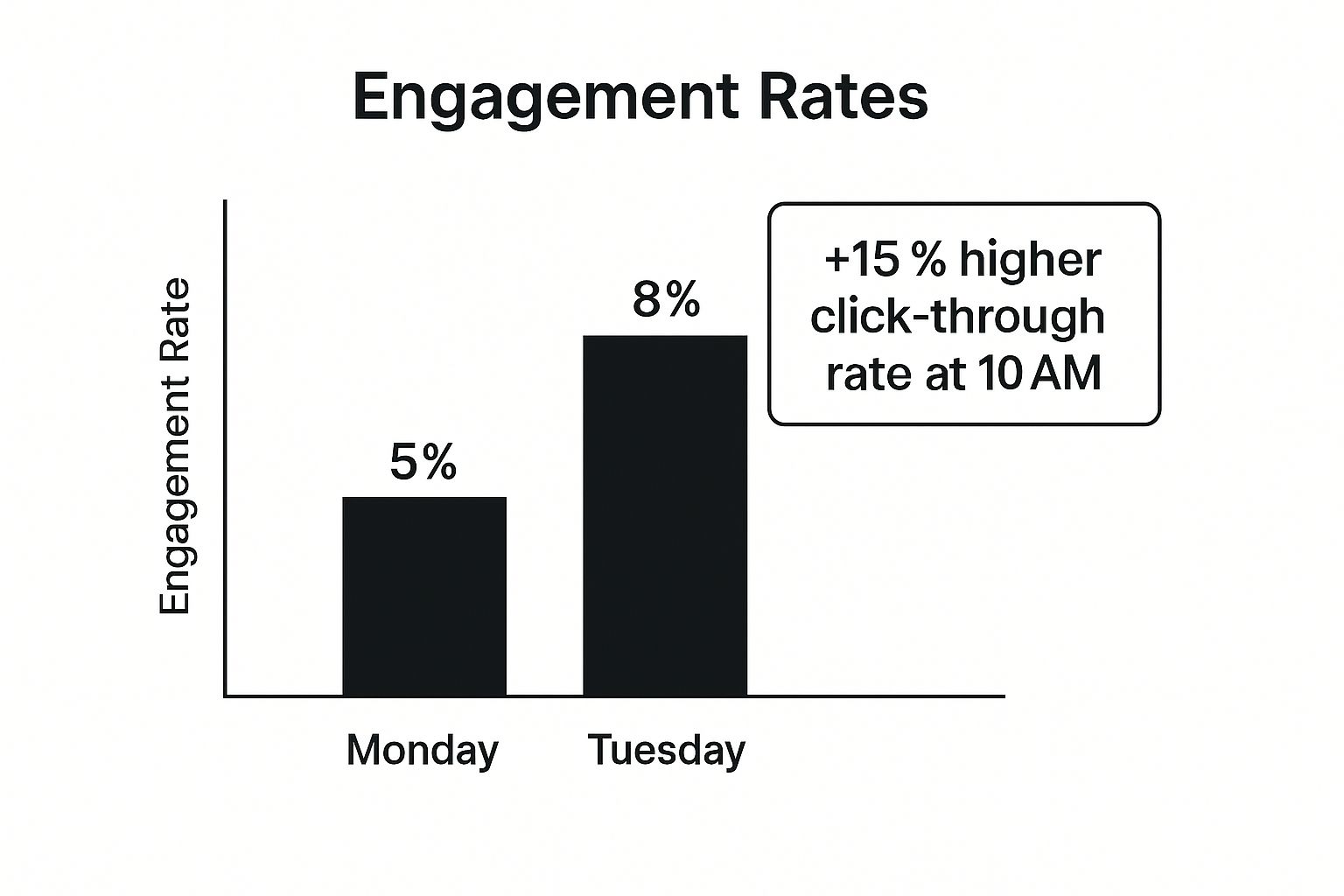
The visualization highlights Tuesday's significant advantage, particularly the impressive 15% higher click-through rate compared to the start of the week.
Why Tuesday Works So Well
Tuesday's strength comes from its position in the weekly timeline. Users have dealt with their initial wave of emails and tasks from Monday and are more open to consuming content. This creates a window of opportunity for brands to capture attention effectively.
- Social Media Examiner reports that Tuesday posts at 10 AM achieve a 15% higher click-through rate (CTR) than those on Mondays.
- Mailchimp data shows that email-to-social campaigns launched on a Tuesday have the second-highest conversion rates of the week, just behind Wednesday.
- Major brands like Nike and Coca-Cola frequently choose Tuesdays to launch new campaigns, leveraging the day's reliable audience reach to build momentum.
How to Make Tuesday Work for You
To leverage Tuesday's consistent performance, it's crucial to align your content strategy with the audience's mindset on this particular day. It's less about viral spikes and more about steady, quality interaction.
- Post in the Optimal Window: Schedule your content between 10 AM and 3 PM. This broad window captures users during their morning focus sessions, lunch breaks, and early afternoon lulls.
- Focus on Educational Content: Use Tuesday to share valuable, informative content. "How-to" guides, industry insights, and educational carousels perform exceptionally well as your audience is in a productive mindset.
- Run A/B Tests: Because of its stability, Tuesday is the perfect day to test content variations. Use it to gather accurate baseline data on what resonates with your audience without the volatility of other days. Postiz makes it easy to schedule different versions of a post to see what performs best.
- Launch Paid Campaigns: Consider starting your paid advertising campaigns on a Tuesday. The combination of high user attention and slightly lower ad competition can lead to a more cost-effective and impactful launch.
5. Platform-Specific Day Optimization
While general trends point to midweek as a strong contender, the true best day for social media posts is not a one-size-fits-all answer. Different social media platforms cater to distinct user behaviors, meaning what works on LinkedIn will likely not produce the same results on TikTok. Applying a platform-specific approach is crucial for maximizing your impact and connecting with your audience when they are most active and receptive.
This strategy moves beyond broad generalizations and dives into the unique ecosystem of each network. Users visit LinkedIn during their professional workday for industry news, while they scroll Instagram for visual inspiration during their downtime. Failing to account for these nuances means you're leaving significant engagement on the table. A tailored schedule ensures your content aligns with the specific mindset and daily habits of users on each platform.
Why Platform-Specific Timing Works So Well
The logic is simple: post where your audience is, when they are there. Each platform has a unique rush hour. B2B professionals check LinkedIn during the workweek, while entertainment-seekers flock to TikTok in the evenings. By aligning your posting schedule with these established patterns, you dramatically increase the chances of your content being seen and engaged with.
- LinkedIn engagement peaks from Tuesday to Thursday around 9-10 AM, as professionals start their workday. Posts during these times can receive up to 3x more engagement than those on weekends.
- Instagram sees high activity on Monday and Thursday. Sprout Social notes that Reels posted on Monday afternoons often achieve a 40% higher reach compared to weekend posts.
- TikTok's prime time is Tuesday through Thursday between 6 PM and 9 PM, capturing users as they unwind after school or work, which is when videos have the highest viral potential.
How to Make Platform-Specific Days Work for You
Capitalizing on these platform nuances requires a deliberate and organized content calendar. Instead of a single posting schedule, you need a multi-faceted one that respects the rhythm of each channel.
- Create Separate Schedules: Use a tool like Postiz to build and automate distinct posting calendars for each social media profile. Schedule your professional thought leadership content for Tuesday morning on LinkedIn and your visually engaging video for Thursday evening on Instagram.
- Analyze Your Own Data: While general studies provide a great starting point, your own analytics are the ultimate source of truth. Use each platform’s built-in insights to identify when your specific followers are most active and adjust accordingly.
- Prioritize and Adapt: Focus your energy on the platforms where your target audience is most active. Review and adjust your strategy quarterly, as user behavior and platform algorithms are constantly evolving. For a deeper dive into a specific platform, you can learn more about the best times and days to post on Facebook to refine your approach.
6. The Monday Morning Strategy
While midweek often claims the top spot for engagement, overlooking Monday morning means missing a unique and powerful opportunity. The Monday Morning Strategy leverages the "fresh start" mentality that most people adopt at the beginning of the week. Users are often scrolling their feeds as part of their work-week startup routine, looking for motivation, planning their week, and getting into the right mindset.
While overall engagement might not reach Wednesday's peak, the right kind of content can perform exceptionally well. Audiences on Monday morning are typically in "planning mode" rather than "leisurely engagement mode." This makes it the ideal time for posts that set a positive tone, announce weekly themes, or provide immediate value for the week ahead, making it a contender for the best day for social media posts for specific goals.
Why Monday Mornings Work So Well
The success of a Monday post hinges on understanding user psychology. People are looking for a spark to kickstart their week. Content that aligns with this need for motivation, organization, and inspiration cuts through the noise. It’s less about deep conversation and more about providing a quick, valuable hit.
- Fitness influencers have noted that their "Motivation Monday" posts often see up to 50% higher engagement than content posted later in the week.
- Gary Vaynerchuk’s famous Monday morning motivational posts consistently achieve above-average reach, tapping directly into the audience's need for a weekly push.
- Productivity apps like Notion and Asana often schedule their best tips for Monday between 8 AM and 9 AM, capturing users as they plan their tasks.
How to Make Monday Work for You
To capitalize on the Monday morning mindset, your content needs to be intentional and timed perfectly. It’s about delivering the right message when your audience is most receptive to it.
- Time Your Posts: Aim to publish between 8 AM and 10 AM. This window captures the crucial morning routine scroll, whether it's during a commute or as people settle in at their desks.
- Focus on Motivation and Planning: Share inspirational quotes, educational tips for the week, or content that helps your audience get organized. Announce weekly campaigns or themes to build anticipation.
- Keep it Concise: Your audience is likely time-pressed and preparing for a busy day. Keep your messages short, impactful, and easy to digest. Avoid hard sales pitches; focus on adding value first.
7. Weekend Posting for Lifestyle and B2C Brands
While weekdays dominate the conversation for B2B marketing, the weekend represents a golden opportunity for lifestyle, retail, and direct-to-consumer brands. Saturday and Sunday are when audiences switch off their work brains and enter leisure mode, spending more time scrolling social media for entertainment, shopping inspiration, and content that aligns with their personal interests.
This shift in user mindset is crucial. Engagement on weekends is often more relaxed and discovery-focused. Users are not just taking a quick break from a task; they are actively looking to be entertained, inspired, or find their next purchase. For B2C brands, this makes the weekend arguably the best day for social media posts aimed at building community and driving consumer interest.
Why Weekend Posting Works So Well
The success of weekend posting is rooted in a fundamental change in user behavior. People have more free time and are mentally open to different types of content. They are planning activities, exploring hobbies, and engaging with brands on a more personal level.
- Fashion giants like Zara and H&M consistently see 30% higher engagement on their Saturday Instagram posts showcasing new collections and user-generated styles.
- Data shows that food and recipe content performs 45% better on weekend mornings as users plan their meals and grocery shopping.
- Travel brand Lonely Planet's Saturday inspiration posts regularly receive double the saves compared to their weekday content, capturing users' aspirational travel planning.
- Home improvement retailers often see peak Pinterest traffic on Sunday mornings, as homeowners browse for DIY projects and renovation ideas.
How to Make the Weekend Work for You
To capitalize on this unique weekend energy, your content strategy must adapt. The focus should shift from professional value to personal connection and visual appeal.
- Time Your Posts Strategically: Aim for Saturday mornings (9 AM – 11 AM) for lifestyle, fashion, and shopping content. Use Sunday evenings (5 PM – 7 PM) for inspirational or "week-prep" content that helps users relax and get ready for Monday.
- Focus on High-Quality Visuals: Weekends are prime time for visually-driven platforms like Instagram and Pinterest. Prioritize high-resolution photos, engaging videos, and aesthetically pleasing graphics.
- Share User-Generated Content: Feature photos and stories from your customers. This builds a strong sense of community and provides authentic social proof when followers are in a buying or discovery mindset.
- Keep it Casual: Avoid professional jargon and corporate-speak. Your tone should be relaxed, friendly, and conversational to match the weekend vibe of your audience. Use a tool like Postiz to schedule this specialized content ahead of time, ensuring you connect with your audience even when you’re offline.
8. Test and Adapt to Your Specific Audience
While industry benchmarks offer a fantastic starting point, the most powerful strategy is to treat them as a hypothesis, not a rule. The ultimate "best day for social media posts" is the day your specific audience is most active and receptive. Every community is unique, shaped by demographics, location, industry, and online habits. Therefore, the most successful social media strategies are built on a foundation of continuous testing and data-driven adaptation.
This approach acknowledges that what works for a global B2B software company will likely fail for a local coffee shop or a beauty influencer. Instead of relying solely on general advice, you must become a student of your own audience. By leveraging analytics tools, you can move beyond guesswork and pinpoint the precise days and times that drive meaningful results for your brand, ensuring your content lands with maximum impact.
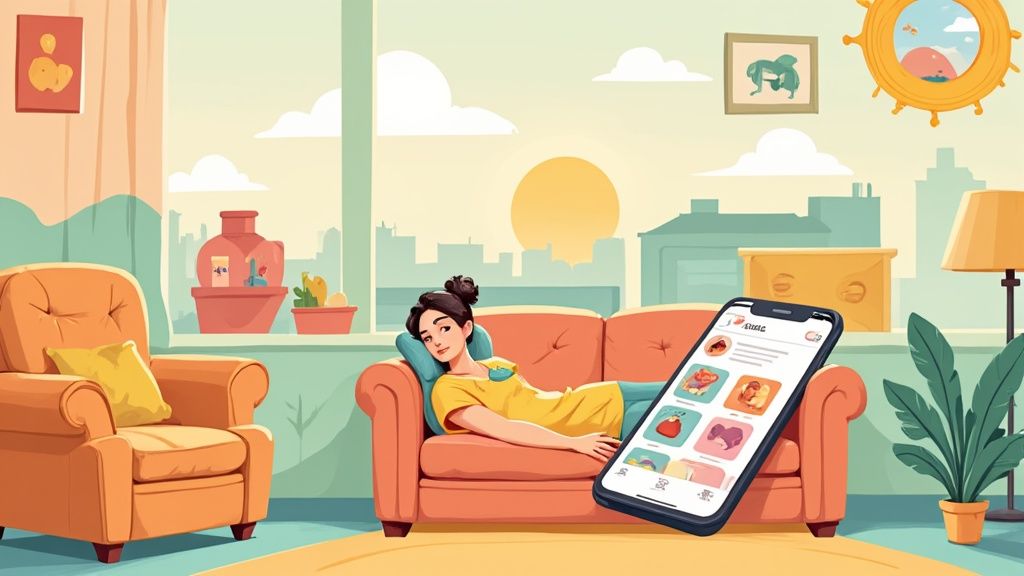
Why Your Own Data is King
Generic data provides the "what," but your own analytics provide the "why." Your audience's behavior is the only truth that matters for your strategy, and sometimes it can be surprisingly counterintuitive. Pioneers of data-driven marketing like Neil Patel and Ann Handley have long advocated for this audience-first approach.
- Glossier discovered through three months of testing that their audience engaged most on Sunday evenings, a time many B2C brands overlook.
- B2B company Drift found their developer audience was most active late on Tuesday nights, well outside traditional business hours.
- A local coffee shop realized that Saturday 7-8 AM posts, while low on social media engagement, drove the most morning foot traffic, directly impacting sales.
How to Test and Adapt Effectively
Implementing a testing framework is simpler than it sounds. It requires patience and a commitment to tracking your performance over time. This process is essential for understanding your audience on a deeper level.
- Commit to a Testing Period: Test each day consistently for at least 4-6 weeks to gather enough data to identify reliable patterns and avoid making decisions based on a single outlier post.
- Use Native Analytics: Dive into the tools already at your disposal. Facebook Insights, Instagram Insights, and TikTok Analytics all provide detailed breakdowns of when your followers are most active.
- Track the Right Metrics: Look beyond simple likes. Focus on engagement rate (likes + comments + shares ÷ followers), reach, website clicks, and conversions to get a true measure of performance.
- Align with Business Goals: Define what success looks like. Is it brand awareness, lead generation, or sales? A post with high engagement but zero conversions might be less valuable than a lower-engagement post that drives traffic to your website. Understanding your audience is the first step, so you can learn more about creating buyer personas to align your content with these goals.
- Document and Review: Keep a simple spreadsheet to track your findings. Review your data quarterly to identify new trends and adjust your Postiz schedule accordingly. This turns social media management from a guessing game into a repeatable science.
Best Days for Social Media Posting: 8-Point Comparison
| Item | Implementation Complexity 🔄 | Resource Requirements ⚡ | Expected Outcomes 📊 | Ideal Use Cases 💡 | Key Advantages ⭐ |
|---|---|---|---|---|---|
| Wednesday: The Peak Engagement Sweet Spot | Medium – requires precise timing and testing | Moderate – scheduling tools recommended | High engagement rates (~20-35% more) across platforms | Launching campaigns, important announcements, B2B & B2C | Peak user attention, better visibility, higher CTR |
| Thursday and Friday: Pre-Weekend Engagement Surge | Medium – balancing content types by day | Moderate – content variety needed | Good to high engagement, especially for entertainment & B2B (Thursday) | Professional content (Thursday), entertainment & lifestyle (Friday) | Last business-week chance, extended engagement windows |
| Avoid Sundays for Professional Content | Low – minimal posting recommended | Low – focus on community or inspirational posts | Low engagement for professional content (40-50% drop) | Inspirational, motivational, community-building content | Less brand competition, lower advertising costs |
| Tuesday: The Consistent Performer | Low to Medium – reliable scheduling | Moderate – steady content flow | Stable and predictable engagement, good CTR increase (~15%) | Testing new content, educational and how-to guides | Consistent performance, balanced competition levels |
| Platform-Specific Day Optimization | High – requires multi-schedule management | High – detailed platform analytics and planning | Optimized reach and engagement tailored per platform | Targeted campaigns across platforms | Maximizes engagement, efficient resource allocation |
| The Monday Morning Strategy | Low – simple timing focus (8-10 AM) | Low – focused motivational content | Moderate engagement, ideal for setting weekly tone | Motivational, inspirational posts, weekly previews | Captures planning mindset, lower competition |
| Weekend Posting for Lifestyle and B2C Brands | Low to Medium – adjusted content style | Moderate – visually rich content | Moderate engagement with longer browsing sessions | Lifestyle, entertainment, retail, consumer brands | Less B2B competition, strong visual and community focus |
| Test and Adapt to Your Specific Audience | High – requires ongoing data analysis | High – analytics tools and time | Most accurate and optimized engagement based on real data | All businesses wanting tailored, data-driven strategy | Competitive advantage, adaptable, ROI improvement |
Automate Your Perfect Schedule with Postiz
Navigating the complex landscape of social media timing can feel like trying to hit a moving target. We've explored the data-driven insights that point to Wednesday as a peak engagement day, the pre-weekend surge on Thursdays and Fridays, and the consistent performance of Tuesdays. We've also delved into why Sundays might not be the best day for professional content and how specific strategies, like the Monday morning motivator, can capture niche attention. But knowing the best day for social media posts is fundamentally different from acting on that knowledge consistently.
The real challenge isn't just identifying these optimal windows; it's executing a flawless posting strategy day in and day out, without letting it consume your entire schedule. This is where theory meets practical application, and where a powerful tool becomes indispensable.
From Insights to Impact: The Power of Automation
The ultimate goal is to transform the key takeaways from this guide into a repeatable, automated workflow. Let’s recap the core principles and how you can implement them systematically:
- Embrace the Mid-Week Powerhouse: Wednesdays, Thursdays, and Tuesdays are your most reliable bets for high engagement across most platforms, especially for B2B and professional audiences. Your content calendar should reflect this, prioritizing your most important messages for these days.
- Segment Your Audience by Day: Not all days are created equal for all content. A B2C lifestyle brand might see fantastic results with a relaxed Saturday post, while a SaaS company will likely find that same slot to be a dead zone. Use your understanding of your audience to assign content themes to specific days.
- Test, Don't Assume: While general data provides an excellent starting point, your unique audience has its own digital habits. The "best day for social media posts" for your brand might be an outlier. Consistent testing and analysis are non-negotiable for long-term success.
Manually logging in to post at 11 a.m. on a Wednesday or 2 p.m. on a Friday is simply not a scalable solution. It’s prone to human error, inconvenient, and takes you away from more strategic tasks like community engagement and content creation.
How Postiz Bridges the Gap Between Strategy and Execution
This is precisely where Postiz transforms your social media management. It’s designed to take all the "when" and "where" complexities off your plate, allowing you to focus on the "what" and "why." Instead of reacting to the clock, you can proactively build a content machine.
With Postiz, you can sit down once and schedule a full month's worth of content based on the principles we've discussed. You can load your high-value LinkedIn articles to go out on Wednesday morning, queue your engaging Instagram Reels for Friday afternoon, and set your thought-provoking Twitter threads for Tuesday lunchtime, all in a single session.
Beyond scheduling, a robust platform is crucial for the "test and adapt" principle. The Postiz analytics dashboard provides clear, actionable data on your post performance. You can easily see which days and times are driving the most impressions, clicks, and engagement for your specific account. This feedback loop allows you to refine your schedule based on your own audience data, moving from general best practices to a perfectly tailored strategy.
Leveraging the right technology is a cornerstone of modern digital marketing. Timing is just one piece of the puzzle. To build a truly efficient growth engine, you need a suite of complementary tools. For a broader look at what can help streamline your efforts, explore these essential startup marketing tools that cover everything from analytics to customer communication.
Ultimately, mastering your social media timing isn't about being glued to your phone. It's about building an intelligent, automated system that works for you, ensuring your best content reaches the right people at the right moment, every single time.
Ready to stop guessing and start scheduling with data-driven precision? Take control of your content calendar and automate your perfect posting schedule with Postiz. Sign up today and transform how you manage social media, ensuring you never miss an optimal posting window again.

